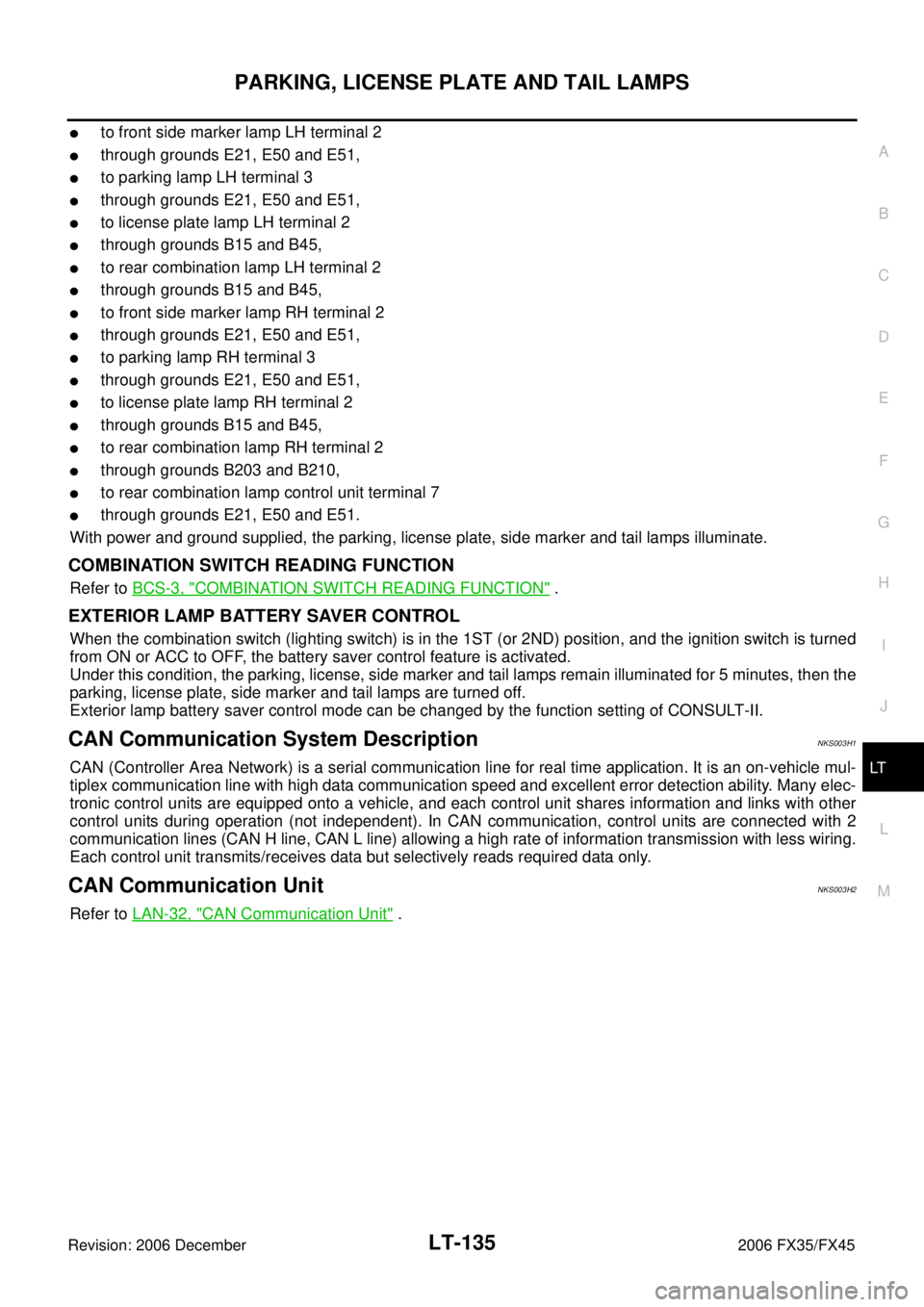Page 3697 of 4462

PARKING, LICENSE PLATE AND TAIL LAMPS LT-135
C
D E
F
G H
I
J
L
M A
B
LT
Revision: 2006 December 2006 FX35/FX45
�to front side marker lamp LH terminal 2
�through grounds E21, E50 and E51,
�to parking lamp LH terminal 3
�through grounds E21, E50 and E51,
�to license plate lamp LH terminal 2
�through grounds B15 and B45,
�to rear combination lamp LH terminal 2
�through grounds B15 and B45,
�to front side marker lamp RH terminal 2
�through grounds E21, E50 and E51,
�to parking lamp RH terminal 3
�through grounds E21, E50 and E51,
�to license plate lamp RH terminal 2
�through grounds B15 and B45,
�to rear combination lamp RH terminal 2
�through grounds B203 and B210,
�to rear combination lamp control unit terminal 7
�through grounds E21, E50 and E51.
With power and ground supplied, the parking, license plate, side marker and tail lamps illuminate.
COMBINATION SWITCH READING FUNCTION
Refer to BCS-3, "COMBINATION SWITCH READING FUNCTION" .
EXTERIOR LAMP BATTERY SAVER CONTROL
When the combination switch (lighting switch) is in the 1ST (or 2ND) position, and the ignition switch is turned
from ON or ACC to OFF, the battery saver control feature is activated.
Under this condition, the parking, license, side marker and tail lamps remain illuminated for 5 minutes, then the
parking, license plate, side marker and tail lamps are turned off.
Exterior lamp battery saver control mode can be changed by the function setting of CONSULT-II.
CAN Communication System DescriptionNKS003H1
CAN (Controller Area Network) is a serial communication line for real time application. It is an on-vehicle mul-
tiplex communication line with high data communication speed and excellent error detection ability. Many elec-
tronic control units are equipped onto a vehicle, and each control unit shares information and links with other
control units during operation (not independent). In CAN communication, control units are connected with 2
communication lines (CAN H line, CAN L line) allowing a high rate of information transmission with less wiring.
Each control unit transmits/receives data but selectively reads required data only.
CAN Communication UnitNKS003H2
Refer to LAN-32, "CAN Communication Unit" .
Page 3752 of 4462

LT-190
ILLUMINATION
Revision: 2006 December 2006 FX35/FX45
�to clock (illumination) terminal 3
�to hazard switch (illumination) terminal 3
�to heated seat switch (driver side) (illumination) terminal 5
�to heated seat switch (passenger side) (illumination) terminal 5
�to door mirror remote control switch (illumination) terminal 16
�to LDW switch (illumination) terminal 5
�to combination switch (spiral cable) terminal 26
�to microphone terminal 2 (with telephone system)
�to A/C and AV switch (illumination) terminal 3
�to DVD player (illumination) terminal 12
�to coin box illumination terminal 2
�to rear power window switch LH and RH (illumination) terminals 6,
�through combination switch (spiral cable) terminal 18
�to audio steering switch (illumination), and
�to icc steering switch (illumination) (with icc)
�to ascd steering switch (illumination) (without icc)
Illumination control
�through combination meter terminal 19
�to A/T device (illumination) terminal 12
�to snow mode switch (illumination) terminal 6
�to VDC off switch (illumination) terminal 4
�to clock (illumination) terminal 4
�to hazard switch (illumination) terminal 4
�to heated seat switch (driver side) (illumination) terminal 6
�to heated seat switch (passenger side) (illumination) terminal 6
�to door mirror remote control switch terminal 15
�to LDW switch (illumination) terminal 4,
�to combination switch (spiral cable) terminal 27
�to A/C and AV switch (illumination) terminal 4
�to DVD player (illumination) terminal 10,
�through combination switch (spiral cable) terminal 21
�to audio steering switch (illumination), and
�to icc steering switch (illumination) (with icc)
�to ascd steering switch (illumination) (without icc)
Ground is supplied at all times
�to glove box lamp terminal 2, and
�to coin box illumination terminal 3
�through grounds M35, M45 and M85,
�to rear power window switch LH and RH (illumination) terminals 7
�through grounds B15 and B45.
With power and ground supplied, illumination lamps illuminate.
EXTERIOR LAMP BATTERY SAVER CONTROL
When the lighting switch is in the 1ST or 2ND position (or if auto light system is activated), and ignition switch
is turned from ON or ACC to OFF, battery saver control function is activated.
Under this condition, illumination lamps remain illuminated for 5 minutes, then illumination lamps are turned
off.
When the lighting switch is turned from OFF to 1ST or 2ND position (or if auto light system is activated) after
illumination lamps are turned off by battery saver control, and illumination lamps illuminate again.
Exterior lamp battery saver control mode can be changed by the function setting of CONSULT-II.
Page 3766 of 4462
LT-204
BULB SPECIFICATIONS
Revision: 2006 December 2006 FX35/FX45
BULB SPECIFICATIONSPFP:26297
HeadlampNKS002Z8
Exterior LampNKS002Z9
Interior Lamp/IlluminationNKS002ZA
Item Wattage (W)
High/Low (Xenon type) 35 (D2S)
Item Wattage (W)
Front combination lamp Front turn signal lamp 21 (amber)
Daytime/Parking lamp 21/5
Front side marker lamp 3.8
Rear combination lamp Stop/Tail lamp and Rear Turn signal lamp LED
Rear side marker lamp 3.8
Front fog lamp 35 (H8)
Back-up lamp 18
License plate lamp 5
High-mounted stop lamp (back door mount) LED
Item Wattage (W)
Map lamp 8
Interior room lamp 10
Personal lamp 8
Luggage room lamp 8
Step lamp 5
Glove box lamp 1.4
Vanity mirror lamp 1.32
Ignition key hole illumination 0.8
A/T device illumination lamp 1.4
Coin box illumination lamp 1.4
Page 4040 of 4462

RFD-2
PRECAUTIONS
Revision: 2006 December 2006 FX35/FX45
PRECAUTIONSPFP:00001
Service Notice or PrecautionsNDS000BH
�Check for the correct installation status prior to removal or disassembly. If matching marks are required,
be certain they do not interfere with the function of the parts when applied.
�Overhaul should be done in a clean work area, it is preferable to work in dustproof area.
�Before disassembly, using steam or white gasoline, completely remove sand and mud from the exterior of
the unit, preventing them from entering into the unit during disassembly or assembly.
�Check appearance of the disassembled parts for damage, deformation, and unusual wear. Replace them
with a new ones if necessary.
�Gaskets, seals and O-rings should be replaced any time when the unit is disassembled.
�In principle, tighten bolts or nuts gradually in several steps working diagonally from inside to outside. If
tightening sequence is specified, observe it.
�Clean and flush the parts sufficiently and blow-dry them.
�Be careful not to damage sliding surfaces and mating surfaces.
�When applying sealant, remove the old sealant from the mounting surface; then remove any moisture, oil,
and foreign materials from the application and mounting surfaces.
�Always use shop paper for cleaning the inside of components.
�Avoid using cotton gloves or shop rags to prevent entering of lint.
�During assembly, observe the specified tightening torque, and apply new gear oil, petroleum jelly, or multi-
purpose grease as specified for each vehicle, if necessary.
Page:
< prev 1-8 9-16 17-24